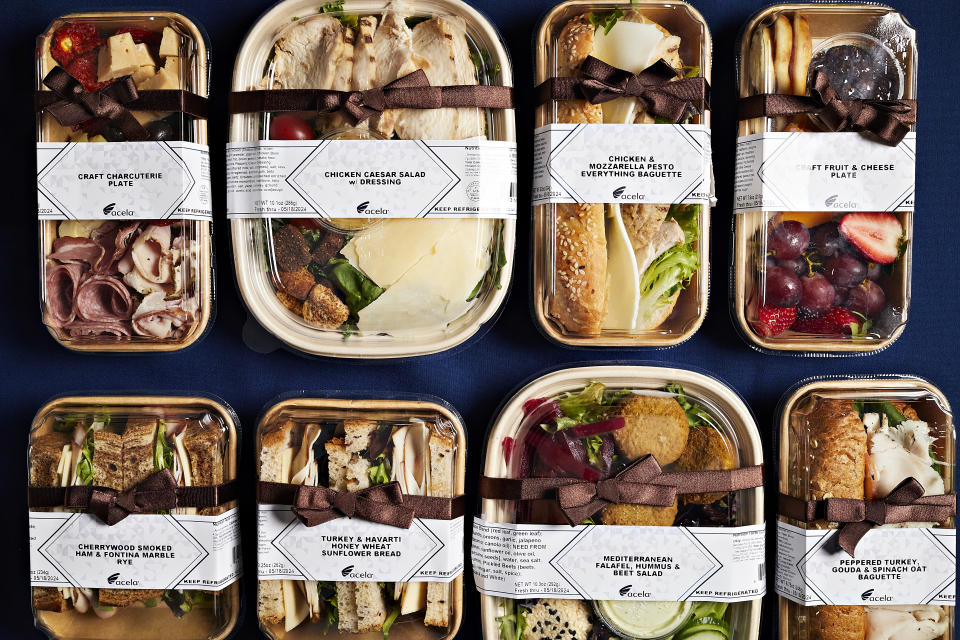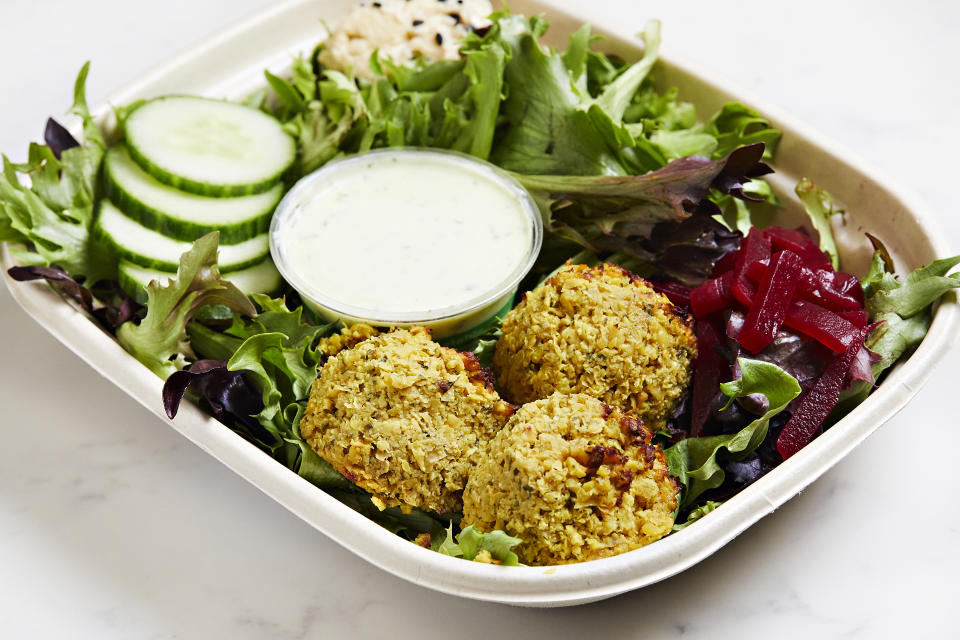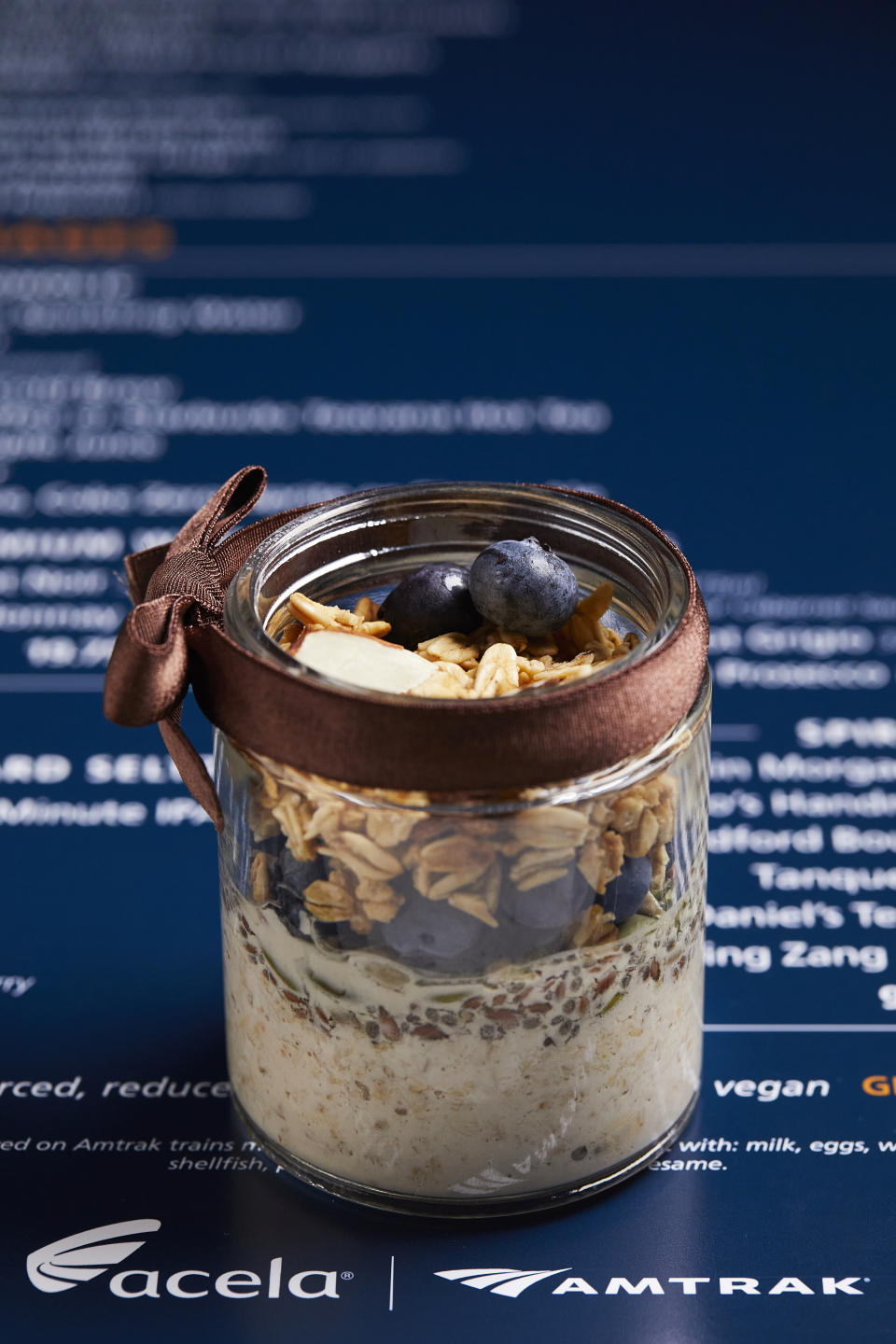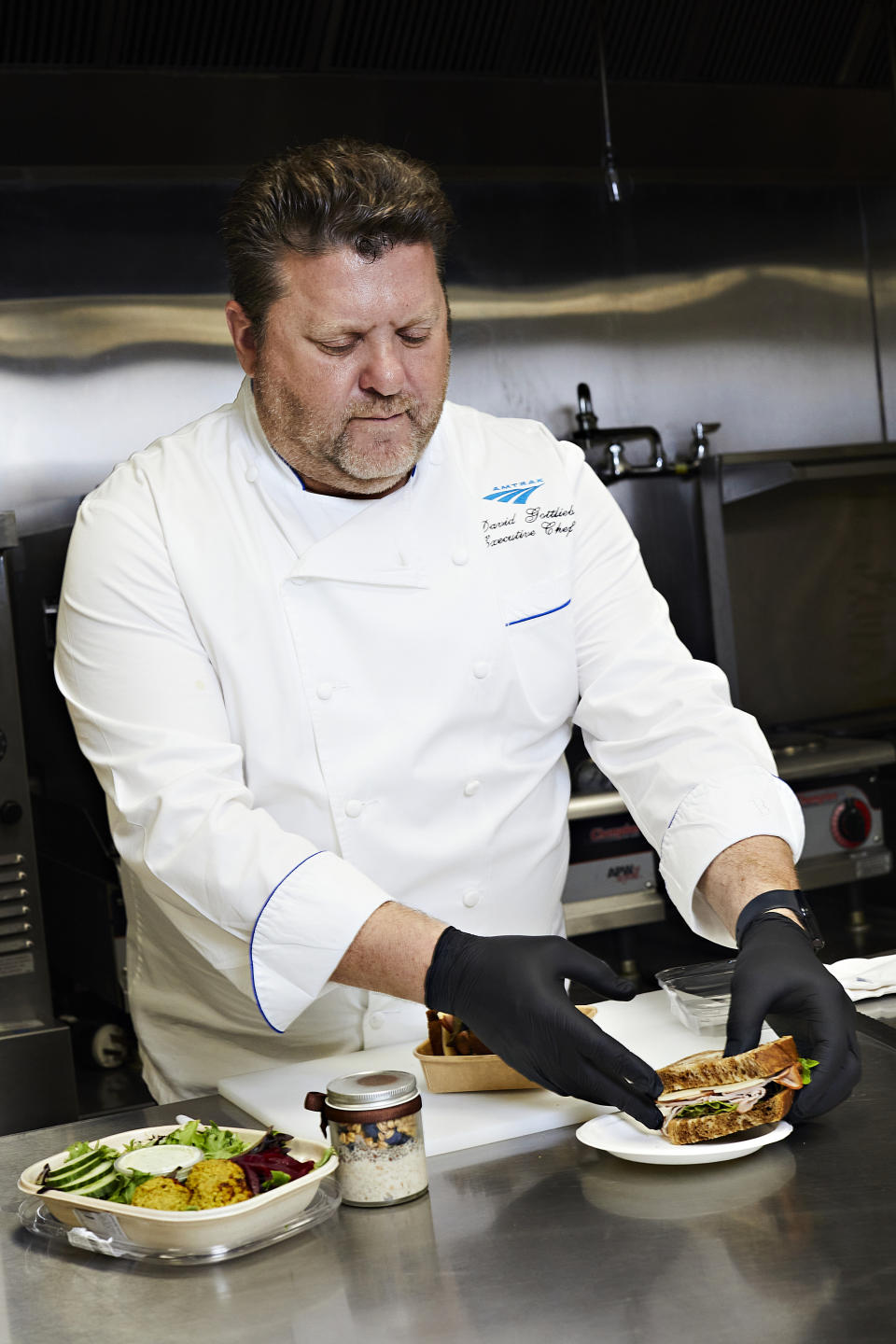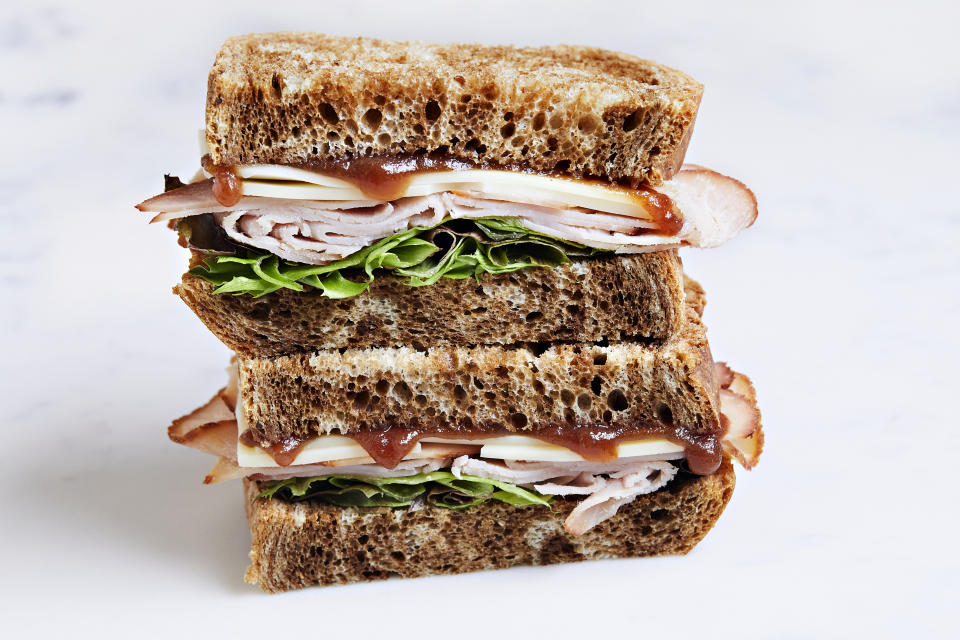Amtrak’s Acela upgrades its menu to match its speed
WILMINGTON, Del. - When Amtrak launched the high-speed Acela Express train in 2000, the big selling point was a faster ride for time-pressed passengers looking to zip from city to city along the East Coast.
But Acela riders don’t crave just speed, it turns out; they expect an experience that’s better than the one they might find on the regular Northeast Regional line. And that, Amtrak officials say, means charcuterie. And pesto. And sandwiches on oat baguettes.
After introducing a menu for first-class Acela travelers that was developed by famed restaurateur Stephen Starr, Amtrak is turning its attention to the rest of us in the cheap(er) seats in business class. On Wednesday, Amtrak plans to introduce a revamped menu for its Cafe Acela that caters to the more refined tastes of its clientele. Now, when riders weave their way into the cafe car for a lunch or snack, they’ll find a selection that’s meant to be a cut above the one offered on the Northeast Regional.
“When someone buys a ticket on Acela, they are buying a ticket for an experience, not just to get from Point A to Point B,” says Eliot Hamlisch, Amtrak’s executive vice president and chief commercial officer. “The food and beverage is an important part of that, and we want to offer a truly elevated experience for our most premium product.”
And so the ham being served isn’t any old pedestrian pig; it’s “cherrywood smoked.” The titular protein in a turkey and cheese sandwich is peppered. The biggest upgrade might be found in the two snacky, shareable “plates” that are far from the usual cheese-and-crackers formula. The revamped menu also swaps in four sandwiches, two salads, and a serving of overnight oatmeal and berries.
To taste the menu before it debuts on Wednesday, I’ve come to the Amtrak test kitchen, a commercial-style facility in an Amtrak office in Wilmington where the company develops recipe ideas and tests out new items.
Here, among the stainless steel racks of condiments and gleaming metal tables, a wall of small ovens represents the collection of models installed in the Amtrak fleet (the ovens have latches that prevent the doors from swinging open). As he shows me around, Amtrak executive chef David Gottlieb pauses to show off the TurboChef, a compact convection oven that quickly crisps food without the mush factor a microwave can impart. “It’s really a game changer,” he says.
The food actually served on the trains isn’t made here, but in a vendor’s large-scale commercial facility outside Baltimore-Washington International Marshall Airport. Amtrak used to use three kitchens along the line but has found that by centralizing production, it can get better consistency. Otherwise, “you might have people folding ham three different ways,” says Jack Kelly, Amtrak’s senior director for food and beverage services.
Perched on a stool pulled up to a counter with the new items spread out before me like a vast picnic, I start out by digging into the two plates, which offer the kind of grazing I typically like to do when I’m traveling.
The charcuterie version was my favorite, starring little rosettes of prosciutto, salami and ham along with cubes of a surprisingly potent Asiago cheese. Lighter bites alongside come in the form of sun-dried tomatoes, artichokes and olives. I could quibble and say the artichokes were a touch watery, but it’s the kind of snack I’d happily finish my day with on the way home from an out-of-town meeting. The cheese-and-fruit version is another grown-up Lunchable, boasting four kinds of cheese - small triangles of cheddar and pepper jack, soft mini wedges of brie, and little balls of mozzarella called ciliegine.
Later that night, at home, I pulled out the containers of both that I had taken with me and enjoyed them on our patio with a glass of rosé. I imagined replating the spread onto a rustic wood board and passing it off as my own assemblage. “I would actually serve this to guests,” I mused to my husband.
The sandwiches, too, are something I would expect from an upscale deli. The breads are all high-quality, seeded varieties, that each add something to the mix. And the handhelds are right-sized, manageable both in terms of not being food-coma-inducing and relatively easy to consume (I could imagine perching one and a drink, along with my ever-present phone, alas, on a fold-down tray). Prices - salads, sandwiches and plates range from $12 to $13.50 - are comparable to those at such an establishment, too, and are higher than those of the items they replaced, which cost $9.50.
My favorite was an admittedly basic combination of turkey and cheese - though Cafe Acela’s version has a few refinements. Here, the honey-wheat sunflower bread and buttery havarti offer a subtle touch of sweetness that’s balanced by a smoky bacon aioli.
I liked the smoked ham and fontina on marbled rye bread when I tried it in Amtrak’s test kitchen, where it was served with apple butter (as it is on the trains). At the time, I found the earthy sweetness of the spread intriguing - but back at home with another one, I swapped the Dijon from my own fridge for the fruit condiment, and I liked the savory version better. Other sandwich options include a grilled chicken and mozzarella with pesto (fresh-tasting but lacking the garlicky punch I prefer - though that’s probably better for the business traveler) and a peppered turkey, Gouda and spinach with a cranberry-Dijon spread.
Team Salad is represented, too. A grilled-chicken Caesar is a fresh, almost-classic iteration, although Gottlieb ditched the usual romaine, he says, in favor of a hardier blend; he had seen too many recalls of romaine over the years, disruptions that could throw wrenches into the already-complicated supply chain. And the Mediterranean falafel salad is another is-this-train-food? moment, with pleasantly cumin-heavy hummus and slivers of pickled beets to punch up the combination.
A surprise favorite was the vanilla-scented overnight oats, which are soaked in oat milk and served in a small glass jar. The texture gets a boost from chia, pumpkin, flax, sunflower and hemp seeds, a topping of slivered almonds and a small handful of blueberries. Diners stir and dig in - and if they’re like me, probably find a day-starter that’s not too sweet, which is the downfall of so many breakfast offerings, and a healthful alternative to a breakfast-sandwich bomb.
Wine, anyone? Why yes, there are two new varieties, an oaky Daou chardonnay and peppy Banshee pinot noir.
Some of the upgrades the company is introducing are subtle, including the fact that the new sandwiches come with small pouches of their condiments nestled alongside them, rather than being pre-applied, to better avoid sog. Another tweak? The containers holding them have gotten an upgrade, which isn’t the kind of thing normal people think about. But then again, the job of the company’s food team is to sweat the small stuff.
Instead of shiny clear plastic, the bases are made of a compostable, cardboard-like material that gives off a slightly more artisanal vibe. A thin, brown satiny ribbon wraps around each box as if it is a miniature present.
Amtrak’s research showed that Acela passengers, in particular, were looking for fresher foods, lighter bites and more options to accommodate different dietary needs, Hamlisch says. The new menu took months to develop, with Gottlieb and others sifting through various options to appease the Acela crowd, folks who might be more health conscious and who are used to dining in upscale restaurants. These days, Acela is catering not just to business travelers but to the “leisure” crowd, too - owing to a shift in ridership after the height of the pandemic.
“It’s a finicky crowd on Acela, and we try to stay ahead,” Kelly says.
The team working on this (and other Amtrak food) has to consider something that your average quick-service restaurant doesn’t: the logistics of serving food in the metal confines of a car hurtling down a track. If the cafe runs out of turkey sandwiches, the staff can’t just pop into a backroom to pull more from a giant walk-in refrigerator. Space is tight - and the stops are fixed. At New York City’s Moynihan station, for example, crews have exactly 14 minutes while the train is stopped to get as many as nine carts onto the train and the empty ones out. Each cart is packed, “Tetris”-like, with all the food, drinks, glassware and other items that will - hopefully - tide the train over until the next reloading spot.
To further boost the luxe vibe, Acela is also piloting in-seat service, like you might find on airplanes.
All of which, Hamlisch says, is part of the transformation of Amtrak from a transportation company to a hospitality one. Amtrak will monitor the sales data and solicit customer feedback on the new menu, he says, to see what’s working - and Hamlisch plans to personally query the people he sees eating on his weekly train rides.
One thing he knows is that in addition to being discerning, the model Acela passenger is also highly opinionated. He hears plenty of compliments, he says, “but they aren’t shy if there’s something they don’t like.”
Related Content
Fentanyl is fueling a record number of youth drug deaths
In a place with a history of hate, an unlikely fight against GOP extremism
Life in Taiwan is rowdy and proud, never mind China’s threats
